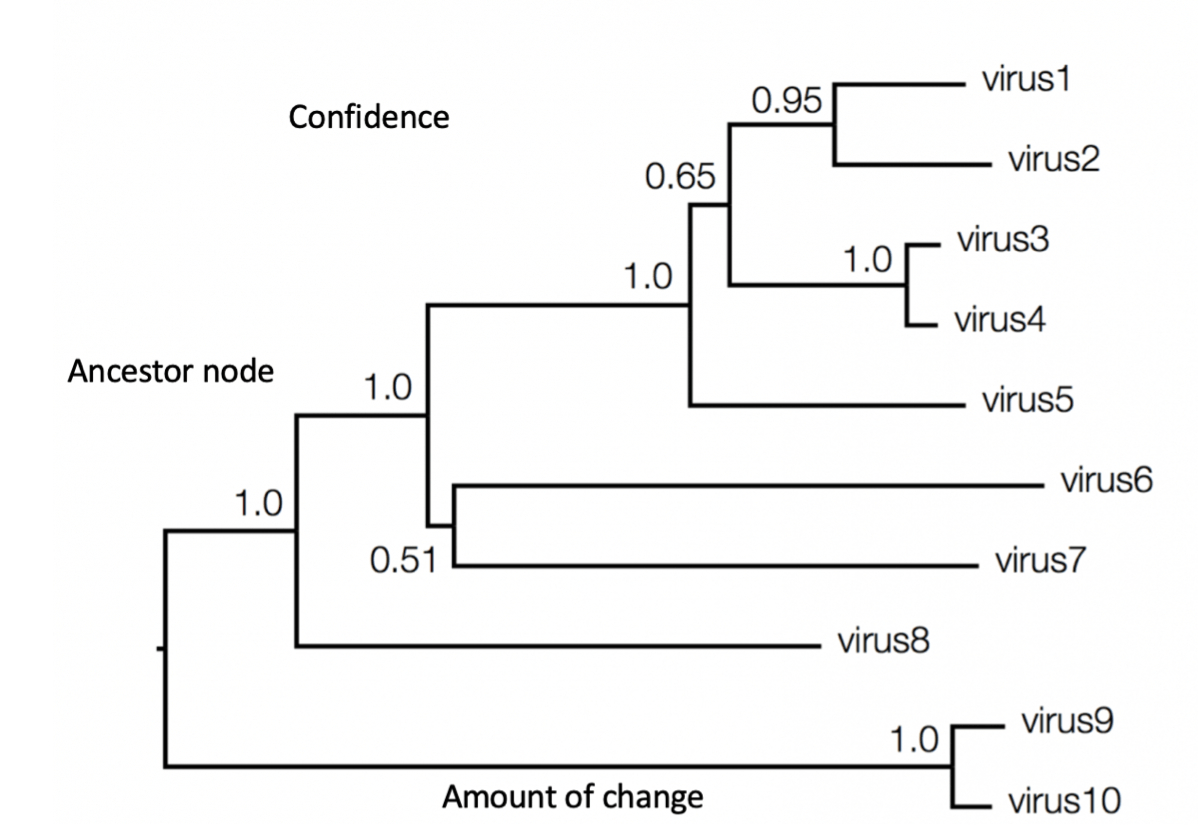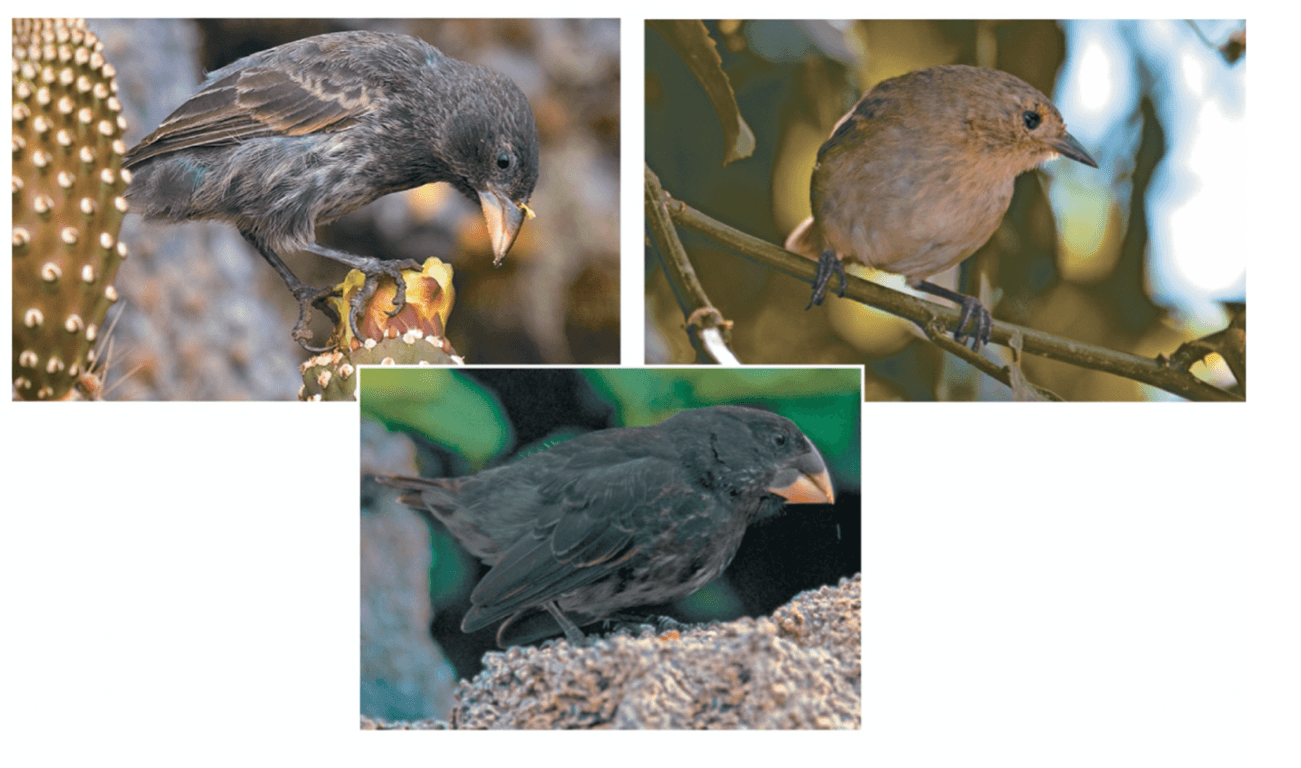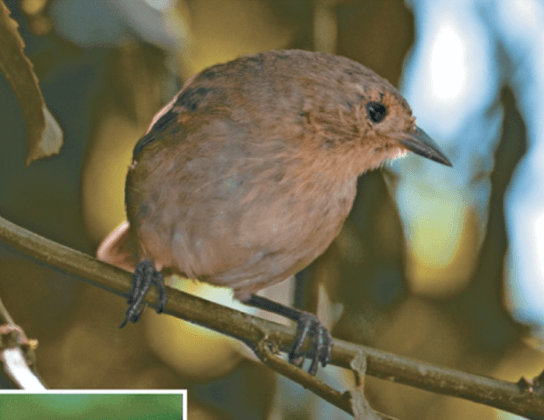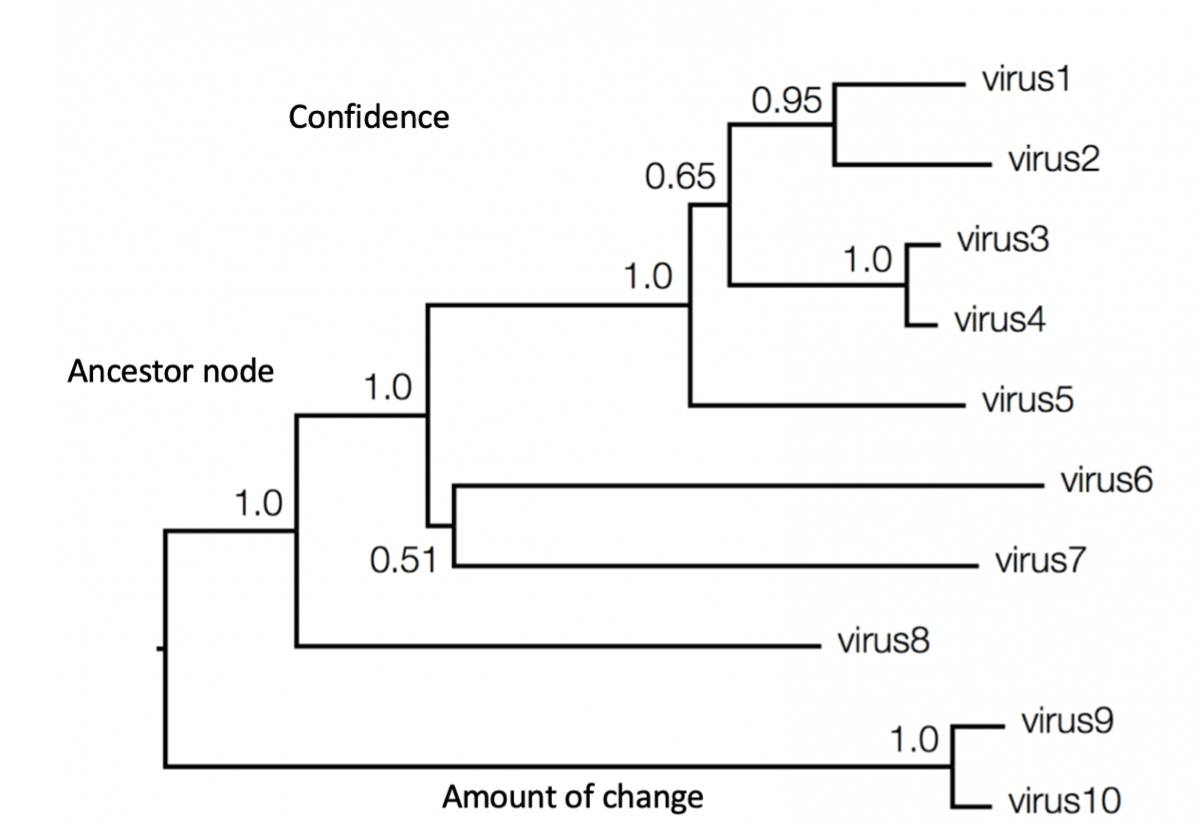Using the Galápagos finches example from the book, which of the following best explains the Darwinian reason why the insect-eating finch has such a long, narrow beak?
A. Variation existed in the finch population. Those that naturally had longer, narrower beaks could reach their food more easily, allowing finches with these features to survive and reproduce more often than those that did not.
B. Every day, finches who needed to eat insects would squeeze their beaks into tiny holes to reach insects, eventually changing the shape of their beaks, which then got passed on to future generations.
C. Those with longer, narrower beaks carried the dominant gene for that, which is how they evolved.
A. Variation existed in the finch population. Those that naturally had longer, narrower beaks could reach their food more easily, allowing finches with these features to survive and reproduce more often than those that did not.
Imagine two species that are thought to have a recent common ancestor. If this idea is correct, these two species most likely have Fill in the blank.
A. no morphological similarities
B. few biochemical similarities
C. several homologous structures
D. shared habitat
C. several homologous structures
On the Galápagos, insect-eating finches (e.g., Certhideaolivacea) look very different from and occupy a very different niche than the seed-eating finches (e.g., Geospiza magnirostris).
What would be the best evidence that these two finch species, in fact, arose from a recent common ancestor?
A. They live in the same island archipelago.
B. They share homologous features like beaks and wings.
C. They have more similar D N A sequences to each other than to other non-Galápagos birds.
D. They mate in the same season.
C. They have more similar D N A sequences to each other than to other non-Galápagos birds.
Evolution can be defined by Darwin’s phrase as
descent with modification
M R S A infections are occurring at alarming rates. One reason for this could be that people do not finish their antibiotics. Which of the following is the most likely reason that this could lead to something like M R S A?
A. Antibiotics take a while to start working, giving the bacteria time to mount defenses against the antibiotics over a few days.
B. Because antibiotics are often taken when there is no bacterial infection, the antibiotics aren’t using their medicinal/antibacterial properties and are losing them.
C. The first few days of antibiotics kill off the most susceptible bacteria, making people feel better. Then, when people stop taking the antibiotics, the less susceptible bacteria that survived have been selected and reproduce to create a more resistant population.
C. The first few days of antibiotics kill off the most susceptible bacteria, making people feel better. Then, when people stop taking the antibiotics, the less susceptible bacteria that survived have been selected and reproduce to create a more resistant population.
Using the Galápagos finches example from the book, which of the following would be a Lamarckian reason why the insect-eating finch has such a long, narrow beak?
A. Variation existed in the finch population. Those that naturally had longer, narrower beaks could reach their food more easily, allowing finches with these features to survive and reproduce more often than those that did not.
B. Every day, finches who needed to eat insects would squeeze their beaks into tiny holes to reach insects, eventually changing the shape of their beaks, which then got passed on to future generations.
C. Those with longer, narrower beaks carried the dominant gene for that, which is how they evolved.
B. Every day, finches who needed to eat insects would squeeze their beaks into tiny holes to reach insects, eventually changing the shape of their beaks, which then got passed on to future generations.
Imagine a whale scientist wishing to refute the theory of evolution by natural selection. Which of the following hypothetical results would provide the scientist with good evidence?
A. Several whales species rapidly go extinct in response to climate change.
B. A new species of whale fossil is found in the Saharan Desert.
C. Climate change is found to cause D N A sequence changes in individual whales that allow them to tolerate the climate changes.
D. A new living whale species is discovered in the Antarctic.
C. Climate change is found to cause D N A sequence changes in individual whales that allow them to tolerate the climate changes.
The sugar glider of Australia and the flying squirrel of North America both share wing-like flaps for leaping from trees. These are thought to result from convergent evolution. What would be the best evidence to support this conclusion?
A. They have a recent common ancestor.
B. Their common ancestor did not have wing-like flaps.
C. They do not share many genes.
D. They have other homologous features.
E. There is very little variation within each species
B. Their common ancestor did not have wing-like flaps.
____ is the study of fossils
Paleontology
Darwin made two main observations and two main inferences on natural selection. Which of these is least likely to apply to cases of human-driven artificial selection, such as that for differing traits in dogs?
A. Observation #1: Members of a population often vary in their inherited traits.
B. Observation #2: All species can produce more offspring than their environment can support, and many of these offspring fail to survive and reproduce.
C. Inference #1: Individuals whose inherited traits give them a higher probability of surviving and reproducing in a given environment tend to leave more offspring than do other individuals.
D. Inference #2: This unequal ability of individuals to survive and reproduce will lead to the accumulation of favorable traits in the population over generations.
B. Observation #2: All species can produce more offspring than their environment can support, and many of these offspring fail to survive and reproduce.
Imagine a species of bird in which females prefer to mate with brightly colored males. However, males with bright backs are more often preyed upon by hawks. Assuming that a wide variety of genetic variation exists in the species, which do you think is the most likely evolutionary outcome?
A. Males will be selected to be brightly colored.
B. Females will be selected to choose drab males.
C. Males will be selected to have bright chests and dull backs.
D. Females will not mate.
E. The species will go extinct because the hawks catch all the males.
C. Males will be selected to have bright chests and dull backs.
Darwin recognized that fitness is a function of the organism’s interaction with its environment. Which would not be an aspect of an organism’s environment that could affect its fitness?
A. the season in which it is born
B. the predators it faces
C. the food sources available to it
D. its birth weight
D. its birth weight
Which of the following is not an example of biogeography?
A. Oceanic islands have many endemic species.
B. Similar fossils can be found in South America and Africa.
C. Galápagos tortoise shells vary from island to island.
D. Predicting the effects of climate change on polar bear distribution.
E. All are examples of biogeography.
E. All are examples of biogeography.
•He hypothesized that species evolve through use and disuse of body parts and the inheritance of acquired characteristics
Lamarck
•Humans modify other species over generations through selective breeding of individuals with desired traits, a process called
artificial selection
Darwin made two main observations and two main inferences on natural selection. Which of these is least likely to apply to cases of human-driven artificial selection, such as that for differing traits in dogs?
A. Observation #1: Members of a population often vary in their inherited traits.
B. Observation #2: All species can produce more offspring than their environment can support, and many of these offspring fail to survive and reproduce.
C. Inference #1: Individuals whose inherited traits give them a higher probability of surviving and reproducing in a given environment tend to leave more offspring than do other individuals.
D. Inference #2: This unequal ability of individuals to survive and reproduce will lead to the accumulation of favorable traits in the population over generations.
B. Observation #2: All species can produce more offspring than their environment can support, and many of these offspring fail to survive and reproduce.
You find a section of sedimentary rock in which the strata and some fossils have been exposed. You notice that a clam fossil is in deeper strata than a fish fossil. Using relative dating, which fossil is most likely older?
A. clam
B. fish
C. not enough data to answer

False
I eat insects. Who am I?


•Inference #1: Individuals whose inherited traits give them a higher probability of surviving and ____ in a given environment tend to leave more offspring than other individuals
reproducing
M R S A infections are occurring at alarming rates. One reason for this could be that people do not finish their antibiotics. Which of the following is the most likely reason that this could lead to something like M R S A?
A. Antibiotics take a while to start working, giving the bacteria time to mount defenses against the antibiotics over a few days.
B. Because antibiotics are often taken when there is no bacterial infection, the antibiotics aren’t using their medicinal/antibacterial properties and are losing them.
C. The first few days of antibiotics kill off the most susceptible bacteria, making people feel better. Then, when people stop taking the antibiotics, the less susceptible bacteria that survived have been selected and reproduce to create a more resistant population.
C. The first few days of antibiotics kill off the most susceptible bacteria, making people feel better. Then, when people stop taking the antibiotics, the less susceptible bacteria that survived have been selected and reproduce to create a more resistant population.
Modern whales have no hind limbs as adults but have transient hind limb buds as embryos and maintain rudimentary pelvic bones as adults. According to evolutionary theory, these features are best understood as Fill in the blank.
A. acquired traits adapted to an aquatic habitat
B. homologous vestiges due to common ancestry with land-dwelling tetrapods (four-legged vertebrates)
C. convergent evolution with fish and sharks
D. biogeographical variation
B. homologous vestiges due to common ancestry with land-dwelling tetrapods (four-legged vertebrates)
Virus 5 is older than Virus 8

False
•Natural selection is a process in which individuals with favorable ____ traits are more likely to ____ and _____
•Natural selection is a process in which individuals with favorable inherited traits are more likely to survive and reproduce
This _____ ability of individuals to survive and reproduce will lead to the accumulation of favorable traits in the population over generations
unequal